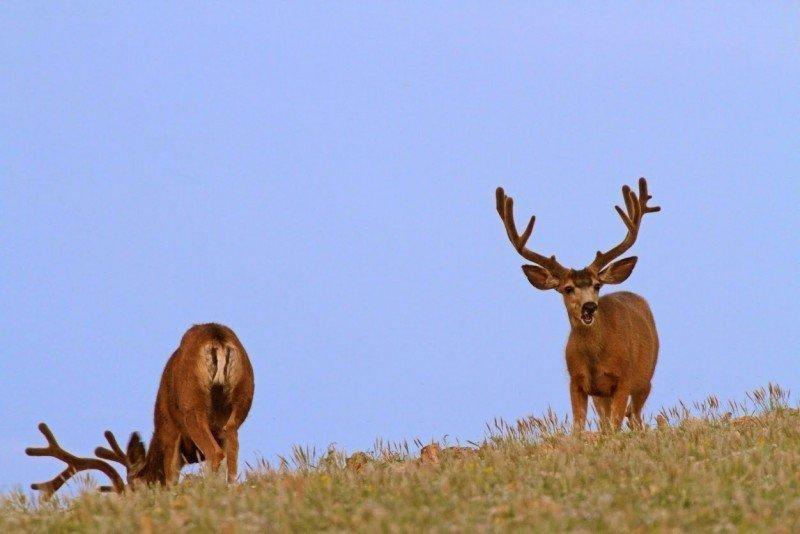DWR Press Release
More than 20,000 general season deer and elk hunters recently responded to a survey about the type of hunting equipment that should and shouldn’t be allowed in Utah.
In addition to revealing equipment hunters would like to use, the survey also found that hunters are happy with some of the restrictions that are currently in place. For example, most of those who responded do not think hunters should be allowed to use crossbows during most of Utah’s deer and elk hunts.
Most of those who responded would also like to see more restrictions. For example, most of the respondents do not think extremely large-caliber firearms, .50 caliber center-fire rifles or larger, should be allowed for hunting in Utah.
Personnel with the Division of Wildlife Resources will share the survey results at an upcoming series of public meetings. You’re invited to attend the meetings, learn more about the survey and share your thoughts with the staff members. Staff will use the survey results and input gathered at the meetings to draft possible changes for the 2016 hunts.
Any proposed changes will be presented to the public at another round of meetings in November.
Before the meetings, you can review the survey results at www.wildlife.utah.gov/public_meetings. Once you arrive at the webpage, click on the ‘Meeting agendas, materials, minutes and audio recordings’ choice under the Regional Advisory Councils subhead.
The results should be posted and available by the first week in September.
An additional item, fishing changes for 2016, will also be discussed at the meetings. The fishing changes will also be available at www.wildlife.utah.gov/public_meetings by the first week in September.
Learn more, share your ideas
After you’ve reviewed the ideas at www.wildlife.utah.gov/public_meetings, you can let your Regional Advisory Council members know your thoughts by attending your upcoming RAC meeting or by sending an email to them.
RAC chairmen will share the input they receive with members of the Utah Wildlife Board. The board will meet in Salt Lake City on Oct. 1 to approve rules for Utah’s 2016 fishing season.
Dates, times and locations for the RAC meetings are as follows:
Northern Region
Sept. 8 – 6 p.m.
Brigham City Community Center
24. N. 300 W.
Brigham City
Central Region
Sept. 9 – 6:30 p.m.
Department of Natural Resources
1594 W. North Temple
Salt Lake City
Southern Region
Sept. 15 – 7 p.m.
Snow College Administration Building
800 W. 200 S.
Richfield
Southeastern Region
Sept. 16 – 6:30 p.m.
City Council Chambers
460 E. Main St.
Green River
Northeastern Region
Sept. 17 – 6:30 p.m.
DWR Northeastern Region Office
318 N. Vernal Ave.
Vernal
You can also provide your comments to your RAC via e-mail. Email addresses for your RAC members are available at www.wildlife.utah.gov/public_meetings.
The group each RAC member represents (sportsman, non-consumptive, etc.) is listed under each person’s email address. You should direct your email to the people on the RAC who represent your interest.
Fishing changes
The major fishing change DWR biologists are recommending would protect kokanee salmon that spawn early in the fall as well as the strain that spawns later. The change would also make it easier to know when you can and can’t keep the salmon you catch.
Biologists are recommending that anglers not be allowed to keep any kokanee from Sept. 10 – Nov. 30, 2016. This closure would be in effect at all of the salmon waters in Utah. Starting Dec. 1, you could keep kokanee up to the legal limit.
Paul Birdsey, cold water sport fisheries coordinator for the DWR, explained how the Sept. 10 – Nov. 30 would protect both strains of salmon.
“Sept. 10 is the peak of the spawn for the strain that spawns early in the fall,” Birdsey said. “Starting the closure on Sept. 10 would allow anglers to keep some fish before the spawn peaks while still protecting the kokanee at the peak of their spawn.”
Birdsey said the peak of the spawn for the later spawning strain occurs around Nov. 10. “So, the Sept. 10 – Nov. 30 closure dates will protect the later spawning strain too,” he said.
In addition to protecting the fish, having the closure happen at the same time on all of Utah’s kokanee waters will make it easier for anglers to know when the closure period is. There are two exceptions, however. Tributaries to Strawberry Reservoir and Sheep Creek, a tributary to Flaming Gorge Reservoir, will be closed to the possession of kokanee during some additional periods too. Some of the tributaries to Strawberry Reservoir are also closed to fishing throughout the year.


